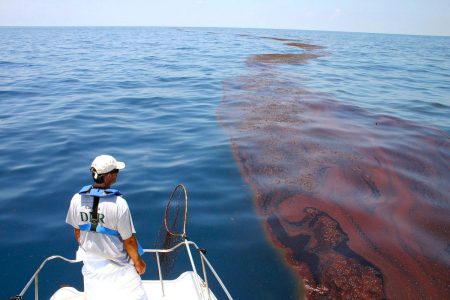December 21, 2018 – It seems appropriate to talk about a characteristic of sunlight with the arrival today of the winter solstice, the annual moment when the Earth’s axis is tilted the furthest away from our sun. During my lifetime there have been a number of major oil spills. The first one I remember was the Torrey Canyon, a supertanker which ran aground off the coast of Wales in 1967 causing the rupture of its storage tanks and the discharge of over 800,000 barrels of oil into the ocean. Britain’s RAF had to bomb the ship to get it to sink and sprayed napalm over the water to ignite and burn the accompanying slick.
Since then the ones I remember include:
- The Amoco Cadiz – in 1978 leaking over 1.6 million barrels onto the Brittany coast of France.
- The Ixtoc Oil Well – took over six months to plug when the well began leaking in 1979 off the Mexican coast spreading oil over 2,800 square kilometers of the Gulf of Mexico.
- The Exxon Valdez – which struck rocks off the Alaska panhandle coastline in 1989 spilling 257,000 barrels into the Pacific Ocean and onto the Pacific Northwest coastline.
- The Deepwater Horizon – an oil drilling platform which in 2010 exploded causing the release of over 500 million barrels into the Gulf of Mexico for more than three months.
At the time of the Torrey Canyon the operator, British Petroleum, had just invented dispersant detergents which were liberally dumped onto the wreck, and even rolled off the Welsh cliffs onto the polluted beaches and rocky shore. Since then fossil fuel and marine shipping companies have come up with all kinds of technology to attempt to break up oil spills on the surface of our oceans. The industry’s oil spill response documents include the latest in dispersants, booms, and skimmers and what works best in cold or warm water, in rough seas, and in windy conditions or calm.
Conventional thinking today says that when an oil spill occurs, it spreads fast with some of the discharge evaporating, and microbes digesting the rest. There is no reference to the role sunlight plays. That is an oversight.
New research published in the last week from, the Woods Hole Oceanographic Institute, Cape Cod, Massachusetts, suggests that oil spills need to be treated differently in the presence of sunlight. The multi-authored article entitled, Partial Photochemical Oxidation was a Dominant Fate of Deepwater Horizon Surface Oil, describes a previously unknown phenomenon.
Sunlight exposure over several days chemically altered 50% of the oil contained within the Deepwater Horizon slick making chemical dispersants less effective. The sunlight played no part in evaporation and so the oil remained on the surface unresponsive to the dispersants that were being dumped into the Gulf. In the end, the oil had to be skimmed up but not before it damaged the biodiversity along the Louisiana coast and in the Gulf.
It appears no one in the fossil fuel and chemical industry had observed this phenomenon before, that sunlight photo-oxidizes compounds to the molecules contained in oil, and binding more oxygen to them altering their makeup. And the longer the oil sat on the surface the greater degree of oxidation.
Within the over three months from the Deepwater oil spill start to the well being capped, almost 500 million barrels entered the water of the Gulf with most of it floating to the surface. There the oxygen contained within oil molecules reacted to sunlight in less than five days.
So why is this important?
Today oil spill response teams prepare and practice using fresh, not weathered oil. They don’t look at how they need to alter their response based on sunlight conditions. But looking back at the Deepwater Horizon case, it is clear that dispersants used today are largely ineffective on photo-oxidized oil. That means we need to invent new dispersants or develop new oil cleanup techniques. And during training crews need to test photo-oxidized oil with boom, skimmer and absorption technology to see if these tools are impacted negatively. Still to be done is an accurate calculation of the photo-oxidizing process subject to different environments, whether cold or warm water or in rough seas.
For Canada, which hopes to build a pipeline from Alberta’s oil sands to a cold water port on the British Columbia coast, testing of the photo-oxidizing effect on heavy synthetic crude, the product being shipped to Asian markets, needs to be done to update spill response standards. This should be part of the environmental due diligence currently underway, and before we witness tanker traffic increases from 5 to 34 per month in the narrow channels linked to the Burnaby. British Columbia, oil terminal.
















